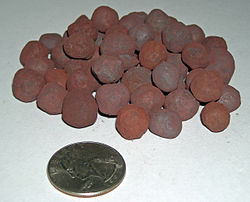Yes the independent lab test of CWRN's fert that R
Post# of 8059
Yes the independent lab test of CWRN's fert that Rocket and I have posted showed a content of 55.42-55.9% iron-which is almost as high as the 2nd international iron benchmark of 58%!!!!
I've never seen retail fert higher than 20%-and its often 4%, so I assume they will have to cut or dilute the fert somewhere in the final processing- CWRN said the Azomite fert from a formation in Utah was only 1.73% iron and it has a lot of silicon dioxide -ca 60%- which is bad-and yet was bringing high prices.
So CWRN should be able to get high prices for the fert -as Bob previously said the fert was worth more (higher price) than the iron product. Possible JV w OMRI via a CWRN onsite fert plant was publicly noted by CWRN ca March- pelleted fertilizer processed by such a plant was bringing 550/ton CWRN noted. Though I suspect they will 1st sell a load of fert without further processing for cash flow, which will help provide CWRN's portion of funds for such a plant if they pursued it.
Taconite
Taconite is a variety of iron formation , an iron -bearing (> 15% iron) sedimentary rock , in which the iron minerals are interlayered with quartz , chert , or carbonate . The term was coined by Minnesota State Geologist Newton Horace Winchell during his pioneering investigations of the Precambrian Biwabik Iron Formation of northeastern Minnesota owing to its superficial resemblance to iron-bearing rocks from the Taconic Mountains of New York, with which he was familiar.
The iron content of taconite, commonly present as finely dispersed magnetite , is generally 25 to 30%.
Contents |
History
In the late 19th and early 20th centuries, there was an abundance of iron ore of such high quality that taconite was considered an uneconomic waste product. By the end of World War II much of the high-grade iron ore in the United States had been exhausted and taconite became a new source of the metal.
Production
To process taconite, the ore is ground into a fine powder, the magnetite is separated from the gangue by strong magnets, the powdered iron concentrate is combined with a binder such as bentonite clay and limestone as a flux and rolled into pellets about one centimeter in diameter that contain approximately 65% iron. The pellets are fired at a very high temperatures to harden them and make them durable. This is necessary to ensure that the blast furnace charge remains porous enough to allow heated gas to pass through and react with the pelletized ore. Firing the pellet oxidizes the magnetite (Fe 3 O 4 ) to hematite (Fe 2 O 3 ), an exothermic reaction that reduces the cost of pelletizing the concentrate. E. W. Davis of the University of Minnesota Mines Experiment Station is credited with developing the pelletizing process. Since the commercial development of this process in the Lake Superior region in the 1950s, the term taconite has been used globally to refer to iron ores amenable to upgrading by similar processes.
Major producers of iron ore pellets from taconite in North America include Cliffs Natural Resources , U.S. Steel , and ArcelorMittal . These processed taconite ore pellets are also referred to as "taconite". Because this is the form that is typically transported by rail and ship, and cargo of these is often discussed, this usage of the term is very common. [ 1 ]
The Mesabi Iron Range region of the American state of Minnesota is a major production area. The taconite iron ore pellets are hauled by railroad through the ports of Silver Bay , Two Harbors and the Twin Ports of Duluth, Minnesota and Superior, Wisconsin , all on Lake Superior . The ore is generally shipped by lake freighters to locations on the lower Great Lakes . Many steelmaking centers are located near Lake Erie . Due to increased international demand, Taconite is now shipped to Mexico and China. [ 2 ]
The cargo of the SS Edmund Fitzgerald , which sank in Lake Superior on November 10, 1975, consisted of approximately 26,116 long tons of taconite pellets.
 (0)
(0) (0)
(0)

